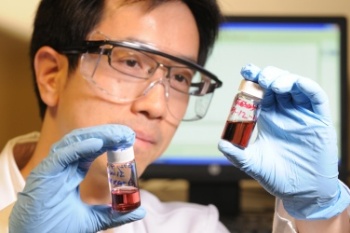Using star-shaped block co-polymer structures as tiny reaction vessels, researchers have developed an improved technique for producing nanocrystals with consistent sizes, compositions and architectures – including metallic, ferroelectric, magnetic, semiconductor and luminescent nanocrystals.
 Georgia Tech professor Zhiqun Lin examines a gold nanoparticle toluene solution. Researchers are using star-shaped block co-polymer structures as tiny reaction vessels for creating nanocrystals. (Georgia Tech Photo: Gary Meek)
Georgia Tech professor Zhiqun Lin examines a gold nanoparticle toluene solution. Researchers are using star-shaped block co-polymer structures as tiny reaction vessels for creating nanocrystals. (Georgia Tech Photo: Gary Meek)
The technique relies on the length of polymer molecules and the ratio of two solvents to control the size and uniformity of colloidal nanocrystals.
The technique could facilitate the use of nanoparticles for optical, electrical, optoelectronic, magnetic, catalysis and other applications in which tight control over size and structure is essential to obtaining desirable properties. The technique produces plain, core-shell and hollow nanoparticles that can be made soluble either in water or in organic solvents.
“We have developed a general strategy for making a large variety of nanoparticles in different size ranges, compositions and architectures,” said Zhiqun Lin, an associate professor in the School of Materials Science and Engineering at the Georgia Institute of Technology. “This very robust technique allows us to craft a wide range of nanoparticles that cannot be easily produced with any other approaches.”
The technique was described in the June issue of the journal Nature Nanotechnology. The research was supported by the Air Force Office of Scientific Research.
The star-shaped block co-polymer structures consist of a central beta-cyclodextrin core to which multiple “arms” – as many as 21 linear block co-polymers – are covalently bonded. The star-shaped block co-polymers form the unimolecular micelles that serve as a reaction vessel and template for the formation of the nanocrystals.
The inner blocks of unimolecular micelles are poly(acrylic) acid (PAA), which is hydrophilic, which allows metal ions to enter them. Once inside the tiny reaction vessels made of PAA, the ions react with the PAA to form nanocrystals, which range in size from a few nanometers up to a few tens of nanometers. The size of the nanoparticles is determined by the length of the PAA chain.
The block co-polymer structures can be made with hydrophilic inner blocks and hydrophobic outer blocks – amphiphilic block co-polymers, with which the resulting nanoparticles can be dissolved in organic solvents. However, if both inner and outer blocks are hydrophilic – all hydrophilic block co-polymers – the resulting nanoparticles will be water-soluble, making them suitable for biomedical applications.
Lin and collaborators Xinchang Pang, Lei Zhao, Wei Han and Xukai Xin found that they could control the uniformity of the nanoparticles by varying the volume ratio of two solvents – dimethlformamide and benzyl alcohol – in which the nanoparticles are formed. For ferroelectric lead titanate (PbTiO3) nanoparticles, for instance, a 9-to-1 solvent ratio produces the most uniform nanoparticles.
The researchers have also made iron oxide, zinc oxide, titanium oxide, cuprous oxide, cadmium selenide, barium titanate, gold, platinum and silver nanocrystals. The technique could be applicable to nearly all transition or main-group metal ions and organometallic ions, Lin said.
“The crystallinity of the nanoparticles we are able to create is the key to a lot of applications,” he added. “We need to make them with good crystalline structures so they will exhibit good physical properties.”
Earlier techniques for producing polymeric micelles with linear block co-polymers have been limited by the stability of the structures and by the consistency of the nanocrystals they produce, Lin said. Current fabrication techniques include organic solution-phase synthesis, thermolysis of organometallic precursors, sol-gel processes, hydrothermal reactions and biomimetic or dendrimer templating. These existing techniques often require stringent conditions, are difficult to generalize, include a complex series of steps, and can’t withstand changes in the environment around them.
By contrast, nanoparticle production technique developed by the Georgia Tech researchers is general and robust. The nanoparticles remain stable and homogeneous for long periods of time – as much as two years so far – with no precipitation. Such flexibility and stability could allow a range of practical applications, Lin said.
“Our star-like block co-polymers can overcome the thermodynamic instabilities of conventional linear block co-polymers,” he said. “The chain length of the inner PAA blocks dictates the size of the nanoparticles, and the uniformity of the nanoparticles is influenced by the solvents used in the system.”
The researchers have used a variety of star-like di-block and tri-block co-polymers as nanoreactors. Among them are poly(acrylic acid)-block-polystyrene (PAA-b-PS) and poly(acrylic acid)-blockpoly(ethylene oxide) (PAA-b-PEO) diblock co-polymers, and poly(4-vinylpyridine)-block-poly(tert-butyl acrylate)-block-polystyrene (P4VP-b-PtBA-b-PS), poly(4-vinylpyridine)-block-poly (tert-butyl acrylate)-block-poly(ethylene oxide) (P4VP-b-PtBA-b-PEO), polystyrene-block-poly(acrylic acid)-block-polystyrene (PS-b-PAA-b-PS) and polystyrene-block-poly(acrylic acid)-block-poly(ethylene oxide) (PS-b-PAA-b-PEO) tri-block co-polymers.
For the future, Lin envisions more complex nanocrystals with multifunctional shells and additional shapes, including nanorods and so-called “Janus” nanoparticles that are composed of biphasic geometry of two dissimilar materials.
This research was supported by the Air Force Office of Scientific Research (AFOSR) under awards FA9550-09-1-0388 and FA9550-13-1-0101. The conclusions expressed in this news releases are those of the principal investigator and do not necessarily represent the official views of the AFOSR.